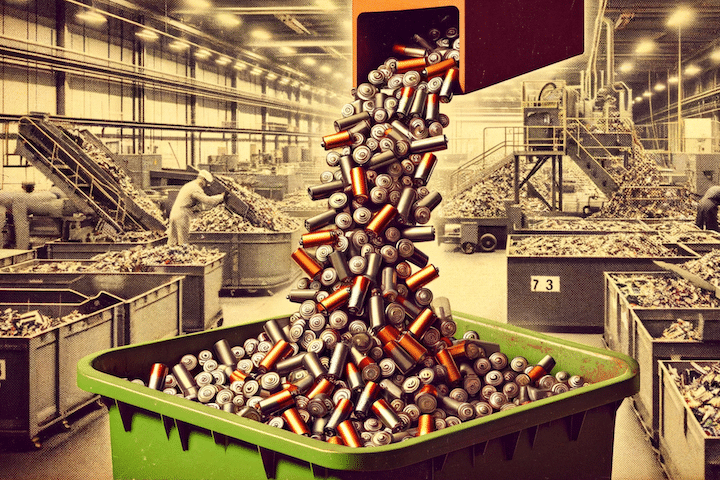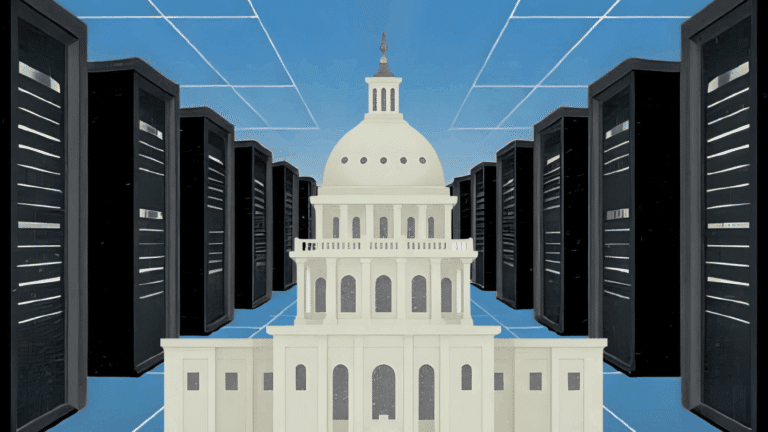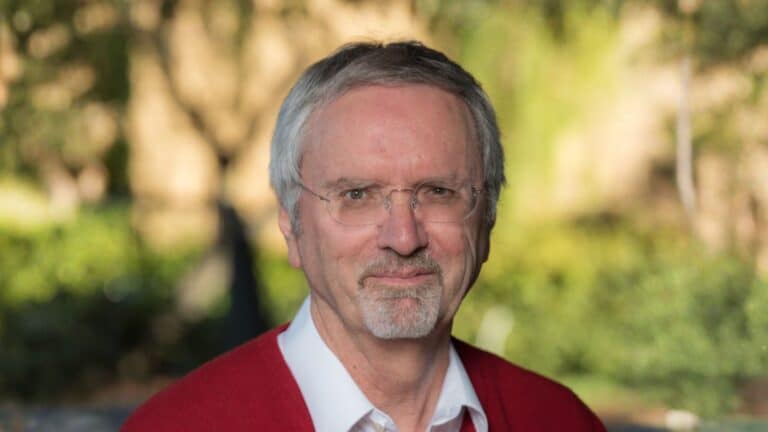This website uses cookies as well as similar tools and technologies to understand visitors’ experiences. By continuing to use this website, you consent to Columbia University’s usage of cookies and similar technologies, in accordance with the Columbia University Website Cookie Notice.
-
Transcript
-
Melissa Lott: [00:00:00] So picture this for a minute. You own a big building. Maybe it’s an office, a church or a school, and your building needs an upgrade. You want to make your building net zero because you’re trying to do right by the planet. Or maybe you think it’s going to save you money in the long run, but you have absolutely no idea where you’re going to start. Now, imagine that there is this single number that you could call where someone would do every step of the building decarbonization process for you. [00:00:27][27.2]
Imaginary phone resource: [00:00:27] This is 1-800. Decarbonize my building. If you have an office building, you’d like to decarbonize. Press one for schools. Press two for restaurants. Press three. Thank you. Please hold the next available decarbonization, Representative. [00:00:42][14.1]
Melissa Lott: [00:00:45] A one stop shop where they handle every step for you. We’re talking about ordering and installing heat pumps, solar panels and LED lights. They’re going to manage your electricians and your ventilation technicians, and they’re going to apply for that bank loan and local permits. They’re going to do all kinds of complicated stuff that most of us just are not experts in. [00:01:03][18.0]
Imaginary phone resource: [00:01:03] Hi, my name is Alexandria, and I’ll be your decarbonization representative today. Who do I have the pleasure of speaking to? [00:01:09][5.9]
Melissa Lott: [00:01:10] How? Alexandria. My name’s Melissa. [00:01:11][1.1]
Imaginary phone resource: [00:01:12] Hi, Melissa. How can I help you today? [00:01:13][1.7]
Melissa Lott: [00:01:14] I have this restaurant here in Austin, Texas, and it really needs an update. I want to upgrade my h-back to a super efficient heat pump so that I can keep the place cool in the summer without spending a fortune. And I’m also thinking about replacing my really drafty windows and maybe having some insulation and, well, there’s rooftop solar. Maybe I should think about that too. [00:01:32][17.4]
Imaginary phone resource: [00:01:32] Sure. Well, let’s get you started. First, we’re going to need. [00:01:35][2.5]
Melissa Lott: [00:01:35] To measure you. But hold on. Unfortunately, right now, that is just not how this works. Today, retrofitting a commercial building can feel like navigating a labyrinth. There are tons of steps and tons of options. What part of the building should you start with a technology should you use? How do you assemble that team of contractors that can actually do it well? And then, of course, how do you pay for it? Decarbonizing buildings is a lot of work, but buildings account for about a fifth of global carbon emissions. And commercial buildings are a big chunk of that. So we need to figure out how to do it and do it fast if we want to fight climate change. So how do we get there? This is the big switch, a show about how to rebuild the energy systems that are all around us. I’m Dr. Melissa Lott and I’m the director of research at Columbia University’s Center on Global Energy Policy. [00:02:37][61.8]
Henrik Mader: [00:02:41] So we worked with a lighting contractor, a roof contractor, a solar contractor and installer. [00:02:47][5.9]
Melissa Lott: [00:02:47] Retrofitting a commercial building means working with lots of people. [00:02:51][3.5]
Henrik Mader: [00:02:52] We worked with our HVAC installers, with the electricians involved in each project with a asbestos abatement team as well. That was part of the project. [00:03:02][10.1]
Melissa Lott: [00:03:02] This is Henrik Mader. [00:03:03][0.8]
Henrik Mader: [00:03:04] We inherited very outdated building systems when we moved in. [00:03:08][3.7]
Melissa Lott: [00:03:08] And this is Jibran Washington. [00:03:10][1.3]
Jibran Washington: [00:03:11] You could be in certain rooms and be really, really hot, which is kind of coming from my room, or it might be really cold and in some other rooms they might be kind of comfortable. So some of us may have been tortured and some of us may have been comforted from our heating system, the whole system. [00:03:26][15.7]
Melissa Lott: [00:03:27] Henrik and Gebran are coworkers and a few years ago they were working in an office building in Detroit, desperately needed an efficiency upgrade, so their workplace decided to do something about it. They wanted to do a complete retrofit of the building, and that’s something that their team actually knew a lot about. Henrik and Gebran work at a nonprofit in Detroit called Eco Works, and it’s this organization that does a bunch of cool sustainability related programs, including helping people to do retrofits on their buildings. [00:03:54][26.6]
Henrik Mader: [00:03:55] So we moved into the building in 2017 and just, you know, based on our background as a nonprofit working on energy sustainability and community development, we pretty much immediately wanted to start exploring options to make it more efficient. [00:04:06][11.3]
Melissa Lott: [00:04:07] We’re going to break down the retrofitting process for a commercial building like the one that Ecovacs owns in just a few steps. But first, I want to go through some basics. In this episode, we’re going to focus on retrofitting existing buildings instead of the question about how we build new ones. This is because existing buildings are a bigger part of the problem than new construction. If we look at buildings overall by 2050, 80% of energy uses in these buildings is going to come from things that have already been built while 20% is going to come from new construction. So first, let’s talk about what exactly commercial buildings are. [00:04:41][34.1]
Paul Mathew: [00:04:42] It’s schools, offices, hospitals, retail, public facilities of of all sorts, grocery stores, restaurants. [00:04:49][7.3]
Melissa Lott: [00:04:50] This is Dr. Paul Mathew, a staff scientist at Lawrence Berkeley National Lab, where he studies buildings. And the first thing to know about buildings is that it’s completely possible to turn old, inefficient ones into net zero ones. [00:05:02][12.4]
Paul Mathew: [00:05:03] We mostly have the technology. We know what to do here. [00:05:06][2.5]
Melissa Lott: [00:05:08] And there are a handful of buildings that are already hitting net zero. [00:05:11][2.5]
Paul Mathew: [00:05:12] There are more than 700 net zero buildings already operating in the United States today. There’s a little database. It’s actually run by the New Buildings Institute. And anybody can Google it. You can go check it out. You can filter these buildings by type. They’re all across the U.S. They’re different sizes. They’re different types. There are schools. There are public facilities. There are offices. There are retail stores. So we have evidence proof. We know how to do this. These buildings exist today. [00:05:41][29.0]
Melissa Lott: [00:05:41] But there are still more than 5.5 million commercial buildings in the U.S. that aren’t doing it. So if this entire transition to net zero and making buildings more energy efficient and reducing their carbon impact, like if it saves them money and also makes their environment better, which could help them make even more money, why is the number 700 and not 700 million or whatever huge numbers? Like why not? Like, why aren’t we there? [00:06:12][30.6]
Paul Mathew: [00:06:13] Exactly. That that, that that is that is truly the challenge. I mean, there’s this big what I call the yawning adoption gap. [00:06:19][6.0]
Melissa Lott: [00:06:24] The first big reason for this massive gap is that there’s just a lack of requirements. A government will often require that a new building meet energy efficiency standards. But like we said before, existing buildings are a bigger part of the problem for carbon emissions. And most places, they just don’t require that existing buildings meet the same efficiency targets, except in a few places where they’re trying out something new called building performance standards. [00:06:48][24.0]
Paul Mathew: [00:06:49] Building performance standards. These are standards that are being passed by cities and states in the US right now that require existing buildings to meet a level of performance. So basically every building gets an energy or a carbon budget. If you don’t and you have to comply by a certain year, if you don’t meet your budget, then you have to pay a fee for the amount that you exceed. So New York City, where you’re sitting right now, has a local law, 97, that essentially sets a target for every building. [00:07:23][34.3]
Melissa Lott: [00:07:24] A few places have adopted building performance standards, including the European Union and a number of U.S. states like Colorado, Washington State and Maryland and our cities. Besides New York, we have cities like Saint Louis, Reno and Washington, DC that have adopted standards, too. But these countries, states and cities, they represent a tiny minority of the world. Most of the buildings that we see today are just not required to be energy efficient, much less zero carbon. And that’s a problem. So if we currently don’t mandate upgrades for all buildings, the most building owners are making those upgrades voluntarily. This means that those building decarbonization efforts have to be both a high priority for them and affordable. And that’s a tough combination. [00:08:07][42.7]
Paul Mathew: [00:08:08] A lot of people just don’t even think about efficiency and energy costs in their building. It’s just treated as a fixed costs that whatever its my energy bill, I’ll pay. It’s not it’s not a huge as a part of my overall expenses and so on. I don’t know. You might have heard that three 3304. [00:08:23][14.9]
Melissa Lott: [00:08:24] Million. [00:08:24][0.0]
Paul Mathew: [00:08:25] Things for example which is I spend $3 a square foot on energy. I spent $30 a square foot on rent. I spent $300 a square foot on my occupants on salaries. So, you know, it’s just there’s a salient question of like, you know, do I even pay attention to it? [00:08:41][15.6]
Melissa Lott: [00:08:44] So what Paul is saying here is that energy costs aren’t always top priority for commercial building owners because energy isn’t a big chunk of their costs. One way to make energy a priority is to make energy efficiency a requirement. Like with building performance standards. But another thing that works. Public awareness and demand. [00:09:02][17.1]
Paul Mathew: [00:09:03] In certain markets like San Francisco and say the Washington, D.C. area for office buildings, there’s a demand for green buildings. There’s a demand for efficient buildings, because those tenants in those buildings, those organizations that are renting space in these buildings actually want to be in green or efficient buildings. [00:09:20][17.4]
Melissa Lott: [00:09:21] In the case of Echo Works, which we heard about earlier. Energy efficiency was already a big priority, but they also ran into another big motivator. Things were starting to break. [00:09:30][9.3]
Henrik Mader: [00:09:31] You know, above and beyond the building design not being perhaps the most energy efficient building envelope. There was a number of, you know, maintenance things that hadn’t been performed. The equipment was already very old. [00:09:42][10.7]
Melissa Lott: [00:09:42] The AC in particular would give out a few times a year. [00:09:45][2.3]
Jibran Washington: [00:09:45] It was frequent, I would say at least a couple of times a year. 2 to 3 times we had to call in for service. [00:09:51][6.0]
Melissa Lott: [00:09:52] Big items like HVAC. So that’s heating, cooling and ventilation systems. Well, they can last for 15 to 20 years. And so the moment that you replace equipment, it’s a really important opportunity to get new, efficient technologies into a building. And so Echo Works got started on its retrofit step number one. And that process was figuring out how much energy they were currently using. [00:10:13][20.5]
Paul Mathew: [00:10:13] I think the first thing is to figure out where you are currently in terms of your energy use. And there’s a very simple process called benchmarking energy benchmarking. [00:10:22][8.5]
Melissa Lott: [00:10:23] This benchmarking is exactly what Echo Works did. [00:10:25][2.6]
Henrik Mader: [00:10:26] Essentially what we did was set a 12 month long baseline for the building using utility bills and energy usage records. So to say over this 12 months, you know, energy cost us this amount of money and we use this amount of kilowatt hours and natural gas. And so that’s that’s where we’re starting. And then that allows you to set targets and motivate. [00:10:48][21.8]
Melissa Lott: [00:10:49] And this benchmarking is something that anyone can do. [00:10:51][2.5]
Paul Mathew: [00:10:52] There are tools available there for free that, you know, any building owner can go and use these tools and figure out where you are compared to your peers, your peers down the street from you. [00:11:01][9.5]
Melissa Lott: [00:11:02] The next step in retrofitting a commercial building is to figure out what upgrades you need. [00:11:06][4.0]
Paul Mathew: [00:11:06] There’s a range of technological options to retrofit your building. I think that’s going to vary by building. And, you know, the typical approach is you’d get an an energy consultant or an or an auditor or an energy auditor come take a look and create a report for you. And the. Kind of lays that lays those options. [00:11:23][17.0]
Melissa Lott: [00:11:24] It works. Happen to be an organization with the staff to do some of this research on their own. [00:11:28][3.7]
Jibran Washington: [00:11:29] For us, it was helpful to have like a committee, so we call it a green building committee. And those meetings were specifically for staff members to contribute to work on the research, fact finding, gathering, whether whether some types of systems or different supplier companies. [00:11:45][16.6]
Melissa Lott: [00:11:46] For Jibran and his team, it meant doing some of the same kind of research that you or I might do. [00:11:51][4.4]
Jibran Washington: [00:11:51] Yes, some of it was Googling, but following up Googling and just calling contractors or just coming across, you came across something interesting and paying, you know, And so special thin film which you can play on the windows, it’s helps reflect in you know okay and we reach out and so we just kind of just on our own to reach out and then we would bring that back to them. [00:12:11][20.1]
Melissa Lott: [00:12:12] They looked at everything from geothermal to green stormwater and in the end they landed on a few things. They wanted to replace old lighting with LEDs, add insulation, fix a leaky roof, install solar panels and electrify their water heating system. All of this was going to cost a lot of money upfront. Which brings us to the third step in the retrofitting process. Financing. This is the next big hurdle that stops a lot of people from adopting tried and true energy efficiency tech. Research consistently shows that retrofitting pays off, but you need to have a lot of money upfront in order to do it, and that can be hard to get. [00:12:49][37.7]
Paul Mathew: [00:12:50] These things cost money, especially major retrofits are big capital investments and there’s risk associated with that. There is a payoff in terms of energy reductions. You do get obviously a reduction in energy costs over the long term. And and so there is that payoff. The challenge, though, is that it still requires that upfront capital investment. The question will always come up, okay, if I’ve got to make this investment, what is my return on investment? If it’s a lender, it’s like that. Will I be sure that I’m going to get paid back on this? Right? So sometimes if people say that, obviously this makes a great investment, but I just don’t have the capital. [00:13:23][32.6]
Melissa Lott: [00:13:27] One solution to this financing problem is pretty straightforward. You can get someone else to put up the money and today you can do this in a few ways, including by working with an energy service company. [00:13:38][10.3]
Paul Mathew: [00:13:39] They’re called schools for short. And what they do is that they’ll essentially say that we will provide the capital and install it for you, and then you pay us back over ten years or 15 years or 20 years or whatever, whatever the term of the contract is. So that’s a way it’s what’s referred to as third party financing. So a third party comes in, provides that financing, and you pay them back over an extended bit of time from the savings essentially that accrue from those efficiency measures. So that’s a well-established that’s been there for decades. [00:14:12][33.3]
Melissa Lott: [00:14:13] According to Paul, the limitation with these energy service companies are isco’s is that it takes a lot of paperwork and a complex planning process to make them work, which is why we only really see larger organizations tending to use them. We’re talking about municipalities, universities, schools and hospitals. [00:14:29][15.9]
Paul Mathew: [00:14:30] These ESCO projects tend to have higher transaction costs. I mean, they’re usually $1,000,000, and $1,000,000 is typically the minimum. You know, for an ethical project that’s just way beyond the scale of what’s needed for many smaller buildings. [00:14:43][13.1]
Melissa Lott: [00:14:44] And it wasn’t going to work for Echo works. The cost of their upgrades was going to fall below that. [00:14:48][4.0]
Henrik Mader: [00:14:48] So finding financing for all of these projects was definitely the biggest challenge that we faced because as a small nonprofit, it can be pretty difficult to get the amount of capital needed to complete these much deeper building projects. [00:15:01][13.0]
Melissa Lott: [00:15:02] So they went to what’s called a green bank. These are lenders that are set up specifically to invest in low carbon solutions like retrofits. [00:15:09][7.2]
Paul Mathew: [00:15:10] The thing is that doing retrofits in buildings is it’s complex. It’s actually much more complex than doing something like just slapping solar panels on a roof. Right? When you’re messing with the AC and the lighting and the envelope and all that, it’s just much more complex. So when you go to a regular season, it’s just a regular bank for a loan. And even though it makes, you know, from an engineering and financial sense, it makes sense because you’re going to save this much money. And, you know, it’s a good from a from a payback standpoint and so on. Banks, many banks and those lenders don’t have the capacity to figure out, okay, is this good? I mean, it’s it’s complex from an engineering standpoint. Right. So the idea with green banks is that their mission is, in fact, to be able to support these kinds of projects, and therefore, they are more likely to have staff or the consultants, as the case may be, to be able to handle that. [00:16:00][50.2]
Jibran Washington: [00:16:01] They’re going to have or most likely going to have a list of contractors that do this work. And so that’s the key. [00:16:06][5.1]
Melissa Lott: [00:16:07] Ecovacs got a $500,000 loan from a green bank called Michigan Saves, and this was the funding that made it all possible. [00:16:13][6.7]
Henrik Mader: [00:16:14] We were able to secure a longer term loan through that process and that that essentially made this project possible. I don’t know that it would have gotten off the ground without it. [00:16:24][9.6]
Melissa Lott: [00:16:25] There are also some other options that building owners have for financing. You could get a normal commercial loan. You could combine the retrofit loan with your building’s mortgage. And there are some other creative options. But that is exactly the challenge. Figuring out all of this stuff is a hassle. It takes a lot of time. AK The last major roadblock in the retrofit process. [00:16:44][19.8]
Paul Mathew: [00:16:45] The hassle factor, even if something is available, it is makes economic sense for me to do. Is it worth my time and my brain cells to kind of go and do it? And I think for many people there’s that issue of the of the transaction cost aspect of of efficiency, which is that it’s still not super easy if you if you don’t have dedicated staff and you’re not in the space. I mean, you have to figure out what your energy bill is. You have to find the contractors, you have to get the installation done. Construction projects are never fun. They’re always they always have risk, you know, And then, you know, you have to commission the process and, you know, get all the stakeholders buy buying and so on. And think about especially small retail facilities. It’s like I’m doing my thing. I mean, I’m selling pizza or I’ve got a nail salon or I’m doing whatever I’m doing, I’m running my business. Should I take time off to kind of figure out how to make my building net zero? Probably not. [00:17:39][53.7]
Melissa Lott: [00:17:40] So how do we simplify the process? Paul says that we really need easy solutions, like a decarbonization hotline. [00:17:47][6.9]
Paul Mathew: [00:17:51] It would be so great to have one 800 decarbonize my building, you know, And they called one 800 decarbonized by building. And it’s a service provider that comes at benchmarks. Your building identifies what you need, runs the audit, gets the contractors and has it delivered. You know, has that entire chain worked out for you so that you don’t and we have evidence proof that this is helpful on the solar side. Solar really took off in the last couple of decades for two reasons. One was granted cheap solar panels from China. Okay, fine. But but the second big piece of that was that you had these end to end service providers that just, you know, with a phone call, the Google Earth, they look at your house and then they say, okay, we can do this. They developed a commoditized model and said, zero down, here’s your contract, sign it and you’re good to go. We’ll come install and take care of everything. You know, that I think is what we need for energy on the energy efficiency and decarbonization in commercial buildings. Otherwise, it’s not going to scale. It’s just again, people are too busy. They don’t have ceilings and they don’t have time of the skill to be able to figure that out on their own. [00:18:53][62.4]
Melissa Lott: [00:19:01] So here’s the thing. We actually do sort of have one stop shops like this imaginary one 800 decarbonize my building hotline. But these one stop shops just need to scale up dramatically. [00:19:11][10.8]
Paul Mathew: [00:19:13] I think the key is a solution that is actually already out there but needs to vastly expand. And it’s called energy as a service or s. Sometimes they say efficiency as a service or sustainability as a service. There are various, you know, variance on it. But for simplicity’s sake, let’s just call it energy as a service. The idea here is that this is a company. These are this is, you know, a particular kind of company that essentially does that entire chain for you. [00:19:40][27.5]
Melissa Lott: [00:19:41] Okay. So just to be clear, we’ve used two different similar sounding things. Isco’s are energy service companies and energy as a service providers. So echoes are mostly for big customers like schools and governments that have dedicated staff to figure out complex contracts. Where energy is a service is a lot more straightforward. It’s kind of like a Netflix, you know, you just say, I want energy installations and rooftop solar and they say, okay, cool, we’ll get that for you and you pay this monthly fee. [00:20:09][27.6]
Paul Mathew: [00:20:09] So I, as a small business owner or a building owner, can go to contract with an energy service company who will figure out what needs to be done. They bring the financing to the table zero down for me. But sometimes, I mean, sometimes you can add some, but often at zero down, they take care of the installation. They then it will, even after the project is completed, they will even run the assets for you for a particular period of time, like ten years or 20 years or whatever the case may be. Right. So it gives, as one person put it, you know, it gives the building on a one neck to check. You know, it’s and that’s that’s very important because there’s just no again, these owners have no time if you have to, like, you know, coordinate, you know, five different trades and five different entities. Vendor is to kind of get this done right. It’s just not going to happen. It’s not their core business. [00:21:01][51.9]
Melissa Lott: [00:21:02] In Europe, they have energy as a service organization specifically for residential buildings, and they’re often called one stop shops. But we need one stop shop for commercial buildings, too. And Paul says that if we want to scale up energy as a service, we also need to make it much more standardized. [00:21:18][16.6]
Paul Mathew: [00:21:19] I wish there was a one simple thing, but a key element in my view is standardization. When I’m thinking standardization, I really envision something where you go to one of these air vent providers and they say, We’ve got, you know, five package solutions on offer. Package one is we just replace your lighting. Package two is we replace your lighting and we also replace your rooftop units. Package three is we replace your lighting, your rooftop units. And we also do something with the plug loads controls in your building. [00:21:52][32.9]
Imaginary phone resource: [00:21:53] So, Melissa, we’ve got a couple different decarbonization packages that you can choose from. Well, actually our lights and each bag package is on sale right now for 15% off, if that’s something that you’d be interested in. [00:22:05][11.8]
Melissa Lott: [00:22:05] Ooh, that sounds good. So what does that include? [00:22:08][2.4]
Imaginary phone resource: [00:22:09] Well, it includes a full benchmark of your buildings, that is figuring out. Exactly. [00:22:13][4.1]
Melissa Lott: [00:22:13] And while these one stop shops aren’t widespread today, there are some organizations like eco works that are looking at moving into this space. [00:22:20][6.5]
Henrik Mader: [00:22:24] Yes. I will say stay tuned to our future programs. [00:22:28][3.3]
Melissa Lott: [00:22:28] This kind of one stop shop or hotline that handles the whole retrofit for you is not going to single handedly jumpstart the slow pace of commercial retrofits. But this whole challenge is basically a bunch of different problems with a bunch of different solutions that each need to be customized to every single building. We just need a simpler solution. [00:22:47][19.0]
Paul Mathew: [00:22:48] I think, of a bespoke suit, you know, versus a, you know, off the off the rack suit, right? I mean, you can have pretty nice off the rack suit, but nothing’s going to be a bespoke suit right at the end of the day. But, hey, you know, a bespoke suit is, whatever, $2,000 and I can get a pretty good off the rack suit for like, you know, $500. Right. [00:23:08][19.9]
Melissa Lott: [00:23:09] So I will say that I do like the sound of this more affordable off the rack retrofit for my imaginary restaurant. Okay, So let’s recap. If we want to decarbonize commercial buildings, we need to do four things. First, we need to adopt building performance standards or similar policies that require building owners to upgrade their buildings. Second, we need to continue to demand efficiency from our buildings. The more that the public demands efficiency, the higher of a priority it will be for building owners. Three, We need to make financing these retrofits way easier with green banks, energy as a service companies and other funding programs. And four, we need to make this stuff way, way, way simpler. We need things like one 800 decarbonized my building to take off energy is a service providers need to scale up dramatically. In the meantime, there’s still a lot we can do. Just look at eco works. [00:24:02][53.5]
Henrik Mader: [00:24:04] We’re just now starting to see the initial results in terms of energy savings and financial savings compared to the baseline that we set, which was 2019. And so based on only a few months of data, we’re seeing that we have reduced our energy usage by well in excess of 50% and similar for the utility bills. So seeing that happen is really encouraging and. [00:24:26][22.0]
Melissa Lott: [00:24:26] Their heating and cooling system now works way better than before. [00:24:29][3.1]
Henrik Mader: [00:24:29] We’ve now split it into room by room temperature control so everyone’s able to work much more comfortably. You know, we’re able to optimize our energy usage, optimize the back load as well. So it’s a it’s a huge improvement. [00:24:44][14.4]
Melissa Lott: [00:24:48] And that’s our show. Next step, how do we get better rules for our buildings? The Big switch is produced by Columbia University’s Center on Global Energy Policy in partnership with Post-Script Media. This episode was produced by Daniel Waldorf and Alexandra. Her The story editing by and Bailey mixing and scoring was by Sean Marquand and Greg Bill Frank, and the theme song was by Shawn Marquand, and a special thanks to our Columbia team. Kirsten Smith, Cully, Liz Smith and Natalie Volk. Our managing producer is Cecily Meza martinez and our executive editor, Stephen Lacey. I’m Dr. Melissa Lott. And this is the big switch. [00:24:48][0.0]
[1387.4]
There are 5.5 million commercial buildings in the U.S. Why are only 700 of them net-zero? We have the technology to slash carbon emissions from commercial buildings, which account for 16% of all U.S. emissions. And retrofitting commercial buildings saves money and energy for building owners.
So what gives?
In this episode, Melissa talks to Dr. Paul Mathew, who studies buildings as a staff scientist at Lawrence Berkeley National Laboratory. He explains the reasons for this “yawning adoption gap” and offers potential solutions. They dig in on:
- Simplifying the retrofitting process through new solutions like one-stop shops and energy-as-a-service providers
- Finding creative ways to pay for the upfront costs, like green banks and energy service companies
- The governments that are testing out new policies like building performance standards.
Also featured in this episode is EcoWorks, a Detroit non-profit that supports energy security, sustainability and retrofits in southeast Michigan.
The Big Switch is produced by Columbia University’s Center on Global Energy Policy in partnership with Post Script Media. This episode was produced by Alexandria Herr and Daniel Woldorff. Theme music and mixing by Sean Marquand. Story editing by Anne Bailey. A special thanks to Natalie Volk, Kirsten Smith and Kyu Lee. Our executive editor is Stephen Lacey.
More Episodes
The Battery Recycling Dilemma
So far over this season we've traced the global lithium-ion battery supply chain from mining to processing to manufacturing. And we've put it all into a geopolitical and economic context.

The Great Battery Manufacturing Race
China has been the world's biggest battery manufacturer for over a decade. By 2022, according to the IEA, China manufactured 76% of the world's batteries. But that's changing.

The High Stakes for Battery Ingredients
Batteries can replace gasoline in our cars, or diesel in our generators with electricity. But batteries and petroleum-based fuels share something in common: they both rely on energy-intensive processes to turn extracted materials into something useful.

The Mining Conundrum For Critical Minerals
To produce enough batteries to reach global net-zero goals, the International Energy Agency says we'll need to increase production of critical minerals by six fold by 2040. It's a monumental task.

Relevant
Publications
Data Centers and Their Energy Use: Trends in State Capitals
From the east to west and north to south, in red states and blue states, attention to data centers is skyrocketing in state capitals across the United States.

The Nvidia Chip Deal Is a National Security Disaster Waiting to Happen
Trump’s latest proposal would cede the United States’ AI advantage.

Beyond Tariffs: Coercive US Trade Deals and Southeast Asia’s Clean Energy Future
Two trade agreements recently negotiated by the Trump administration contain novel and coercive provisions with little precedent in US trade policy or the global trade system.

Energy is the next battlefield
Without transatlantic alignment, we risk forfeiting the very advantages our alliance was built to protect.


